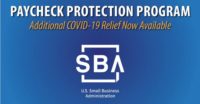There’s an old joke that one of the biggest lies ever told is, “I’m from the government and I’m here to help you.” The punch line generally gets a laugh, but it’s far from funny when applied to how the federal government has undermined a program designed to help small businesses keep their enterprises functioning in the face of the COVID-19 pandemic.

On March 27, President Donald Trump signed the Coronavirus Assistance and Relief (CARES) Act. Among the measure’s provisions was the Paycheck Protection Program (PPP). It authorized the U.S. Small Business Administration (SBA) to provide loans to businesses so they could maintain their payrolls while weathering the economic storm. The loans were forgivable if the borrower maintained its workforce and used the funds for payroll, rent, utilities and other costs. Additionally, the borrower had to certify that current uncertainty “makes the loan request necessary to support ongoing operations.”
The PPP loans became available on April 5, and in less than two weeks, the entire amount allotted by the legislation—$450 billion—was spent. Unfortunately, the requirements posted on the SBA website provided a narrower definition of eligibility than the legislation. On its website, the agency declared that the applicant had to have fewer than 500 employees and annual receipts that met the agency’s small-business size standards for various occupational classifications.
The legislation defined eligibility as meeting either the 500-employee-or-less threshold or the SBA size standard. For most construction firms, the agency defines small businesses as having about $40 million in annual receipts or less.
While most construction firms fall under the 500-employee threshold, SBA’s improper policy of additionally applying an annual receipts standard made many family-owned businesses conclude that they were not eligible. SBA and the U.S. Treasury Dept. later clarified that either condition met the requirement, but this was a preview of confusion to come.
Because the need for the loans exceeded the initial funding, the Trump administration and Congress moved to provide an additional $310 billion. At almost the same time, news media reported that large and, in some cases, publicly held firms were receiving PPP loans. The companies were in fact technically eligible, but the news was not well received by some on Capitol Hill and in the Treasury Dept.
In response, Treasury issued new guidelines on its website in the middle of the night. The directives claimed that recipients of loans in the amount of $2 million or more would be automatically audited, and recipients of lesser amounts would be randomly audited. Treasury gave loan recipients the opportunity to return the loans by May 7, no questions asked.
Compounding that implied threat was the addition of a new loan condition not found in the statute. To be eligible, applicants now needed to certify that they had considered using “other sources of liquidity.”
These new guidelines caused considerable concern in construction, with 18% of AGC-surveyed firms saying they were considering returning the loans, threatening needless new layoffs. Since then, the Treasury has changed its loan return deadline to May 18. The department also announced that recipients of loans below $2 million would automatically be considered qualified. And recipients of loans worth $2 million or more will only be required to repay, without penalty, if later deemed ineligible.
Unfortunately, the department has not clarified what it means by “other sources of liquidity,” or how soon recipients would have to repay those loans, among other details. The lack of clarity is a source of concern because contractors performing public work are generally required to obtain surety bonds to guarantee that they have the means to complete the project. To maintain bonding capacity, contractors need to demonstrate manageable cash flow as well as reserves. Failure to demonstrate ability to make payroll or pay for materials puts their business at risk of defaulting on those bonds.
Congress and the administration provided a needed life preserver to employers whose companies were threatened by the economic storm. But unfortunately for many construction firms, federal agencies keep pulling that lifeline away.
If you have an idea for a column, please contact Viewpoint Editor Richard Korman at kormanr@enr.com.





Post a comment to this article
Report Abusive Comment